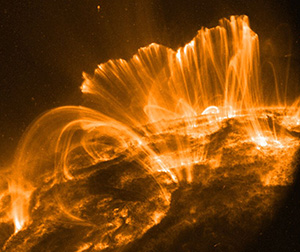Space weather is a fascinating field that examines the electromagnetic energy, magnetic fields, and plasma from the sun that can affect Earth's atmosphere and our technology. Learn how solar activity influences weather and technology.
What is Space Weather?
When we think about weather, we often consider factors like moisture, temperature, and pressure. However, space weather focuses on conditions in space, such as electromagnetic energy (light, x-rays), magnetic fields, and ionized particles (plasma). This video from NASA explains the sun's activity over the last 3 years and its potential impact on Earth’s weather and human technology:
Key Space Weather Phenomena
Here are some of the most significant space weather phenomena and resources for tracking them:
Sunspots
Sunspots are cooler, darker areas on the sun's surface, caused by intense magnetic activity. These sunspots can signal solar flares or coronal mass ejections (CMEs). They typically appear in bands just above and below the sun's equator. When the sun enters a new cycle, sunspots may appear at higher latitudes.
Solar Cycles
Sunspots follow an 11-year cycle, known as a solar cycle. During the peak of the cycle, the number of sunspots increases. Afterward, they gradually decrease. This cycle can overlap with others, which sometimes causes confusion in predictions.
Solar Winds
Solar winds refer to the continuous flow of charged particles emitted by the sun. These winds travel throughout the solar system, impacting planetary atmospheres and affecting technology on Earth.
Solar Flares
 A solar flare is an intense burst of high-energy radiation from the sun's surface. These eruptions occur when magnetic field lines on the sun cross and reconnect, releasing enormous amounts of energy. X-Class solar flares are the most powerful and can cause radiation storms, affecting Earth's atmosphere and causing radio blackouts.
A solar flare is an intense burst of high-energy radiation from the sun's surface. These eruptions occur when magnetic field lines on the sun cross and reconnect, releasing enormous amounts of energy. X-Class solar flares are the most powerful and can cause radiation storms, affecting Earth's atmosphere and causing radio blackouts.
While the Earth's atmosphere absorbs much of this radiation, it can still cause issues with satellite communications, GPS, and sometimes even increase friction on satellites, causing them to fall back to Earth.
Coronal Mass Ejections (CMEs)
A CME occurs when the sun's magnetic field lines become too twisted and snap like a rubber band, releasing vast amounts of plasma. The intensity of a CME depends on the size of the explosion, the strength of the magnetic field, and the speed at which the particles travel. When these charged particles reach Earth, they can cause lightning storms and disrupt power transformers, GPS, and pipelines.
Tracking Space Weather
Tracking space weather is essential to understanding how solar events impact Earth. There are several resources available to monitor these phenomena:
Stay Prepared with Resources
Do you have any resources for tracking space weather? Share them in the comments below!














